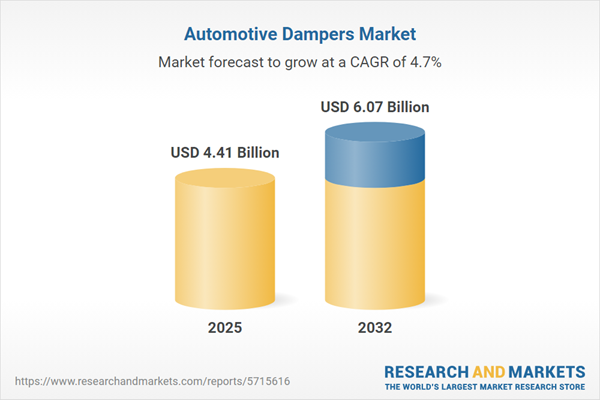Speak directly to the analyst to clarify any post sales queries you may have.
The automotive dampers market is pivotal for senior decision-makers seeking reliable intelligence to inform growth strategies in an era of transformative technological change and evolving regulatory frameworks. As supply chains adapt and industry standards shift, understanding precise market dynamics allows organizations to maintain operational resilience and identify critical investment opportunities.
Market Snapshot: Automotive Dampers Market Size and Growth
The automotive dampers market is poised for steady progression, with a valuation of USD 4.21 billion in 2024 projected to increase to USD 4.41 billion in 2025, reflecting a compound annual growth rate of 4.69 percent. This sustained momentum stems from widespread modernization in vehicle architectures, targeted investment in innovative damper technologies, and continued demand across both passenger and commercial segments. Enhanced use of digital tools and refined supply practices are supporting market expansion, while manufacturers adopting advanced development methodologies are positioned to adapt quickly to changing industry demands.
Scope & Segmentation of the Automotive Dampers Market
- Suspension Types: Includes active electrohydraulic, electromechanical, passive, semi-active, hydraulic, and electrorheological systems, each engineered to meet the specific ride quality requirements and technological standards for current and emerging vehicle categories.
- Vehicle Classes: Dampers are integrated into a broad range of vehicle classes, covering heavy and light commercial vehicles, agricultural machinery, construction equipment, mining vehicles, as well as the complete spectrum of passenger models such as hatchbacks, sedans, multi-purpose vehicles, and SUVs.
- Distribution Channels: Both original equipment manufacturer (OEM) supply networks and the aftermarket channel ensure industry-leading accessibility, supporting component lifecycle management and building resilience within producer and supplier operations.
- Design Configurations: Product variations such as mono tube (featuring floating or solid piston), remote reservoir, pressurized twin tube, and standard twin tube support diverse installation requirements and performance criteria for integration across global vehicle platforms.
- Mounting Positions: Flexible installation options include front and rear chassis placements, as well as single or double tube systems at the rear, optimizing compatibility with new vehicle architectures and contemporary loading needs.
- Regional Coverage: Coverage spans the Americas, Europe, Middle East and Africa, and Asia-Pacific, with market dynamics shaped by localized regulation, ongoing fleet updates, and changes in supply infrastructures. Activity in the United States, China, India, Germany, and Brazil highlights the significance of these markets for regional growth and innovation.
- Leading Companies: Major market participants—such as KYB Corporation, Tenneco Inc., ZF Friedrichshafen AG, Hitachi Astemo, Mando Corporation, BILSTEIN Group, Gabriel Ride Control Inc., DRiV Inc., NHK Spring Co., Ltd., and BWI Group NV—drive innovation by prioritizing digitalized manufacturing and maintaining stringent production benchmarks.
Key Takeaways for Automotive Dampers Market Leaders
- Electrification and automation are increasing the importance of damper designs that offer adaptability across both modern electric vehicle platforms and established models, supporting seamless transitions and future-readiness.
- Employing advanced digital tools and predictive analytics is streamlining design and engineering workflows, accelerating the product lifecycle and ensuring alignment with the ongoing evolution of industry requirements.
- Innovation in materials science, especially with metallurgy and composites, is raising the standards for durability and encouraging suppliers and OEMs to form agile, responsive partnerships for robust component solutions.
- Dynamic regulatory landscapes require manufacturers to build ongoing operational flexibility, maintaining compliance while preserving a competitive edge in performance and innovation.
- Modular architecture adoption is promoting quick customization and faster market introduction of new models, minimizing time-to-market and increasing responsiveness to client demands.
- Customer-driven development necessitates interdisciplinary teamwork, particularly between engineering and software functions, as technical requirements for global platforms escalate.
Tariff Impact: Navigating Trade Pressures and Localization
With new U.S. trade tariffs anticipated for 2025, automotive damper suppliers are expanding regional supply chain capacity and boosting local sourcing. These strategies help moderate cost fluctuations, safeguard consistent product quality, and secure inventory availability for OEMs and aftermarket customers alike.
Methodology & Data Sources
This research is grounded in direct interviews with senior executives from leading automotive OEMs and top-tier damper suppliers. Supplementary insights were compiled from technical publications, patent records, and the latest regulatory updates, yielding a comprehensive perspective on technological progress and global supply chain strategies.
Why This Report Matters for Stakeholders
- Delivers a balanced analysis of technology trends, regulation, and supply chain changes, empowering strategic risk identification and supporting informed opportunity assessments.
- Enables engineering and product management teams to anticipate shifting requirements, maintaining operational and technological alignment during industry transformation.
- Facilitates strategic adaptability, ensuring that innovations are recognized early and minimizing business disruption even as the market landscape shifts.
Conclusion
Senior executives will find actionable insights in this report to guide decision-making, build organizational resilience, and capitalize on future opportunities as the automotive dampers market continues to evolve.
Additional Product Information:
- Purchase of this report includes 1 year online access with quarterly updates.
- This report can be updated on request. Please contact our Customer Experience team using the Ask a Question widget on our website.
Table of Contents
3. Executive Summary
4. Market Overview
7. Cumulative Impact of Artificial Intelligence 2025
Companies Mentioned
The companies profiled in this Automotive Dampers market report include:- KYB Corporation
- Tenneco Inc.
- ZF Friedrichshafen AG
- Hitachi Astemo, Ltd.
- Mando Corporation
- BILSTEIN Group (Christoph H. Bilstein GmbH)
- Gabriel Ride Control Inc.
- DRiV Inc.
- NHK Spring Co., Ltd.
- BWI Group NV
Table Information
| Report Attribute | Details |
|---|---|
| No. of Pages | 182 |
| Published | October 2025 |
| Forecast Period | 2025 - 2032 |
| Estimated Market Value ( USD | $ 4.41 Billion |
| Forecasted Market Value ( USD | $ 6.07 Billion |
| Compound Annual Growth Rate | 4.6% |
| Regions Covered | Global |
| No. of Companies Mentioned | 11 |









